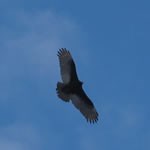
National Park Service Great Falls Park is a haven for birds, and a popular birdwatching place. Over 150 species can be observed in the park throughout the year. These species include songbirds, ducks, and the occasional osprey and bald eagle. In the spring and summer, great blue herons fish around the falls. Fish are their favorite prey, although these tall birds will eat water snakes when they can catch them. Another fishing bird, often seen diving for fish below the falls, is the double crested cormorant. Occasionally, a bald eagle is observed flying over the park. Osprey and gulls will sometimes wander up the Gorge. Red tailed hawks are a common sight. Sharp-shinned, Cooper's, and red shouldered hawks are found here as well. Small mammals and birds make up the bulk of their diets. While hiking through the woods, listen for woodpeckers. Pileated, hairy, downy, and red-bellied are four species that can be spotted in the park. Birdwatchers can look for smaller birds, such as blue jays, Baltimore orioles, mourning doves, goldfinches, cardinals, robins, and thirty five different species of warblers. Bird Walk - Volunteer Guided - Every Sunday 8:00 am. Meet in the Main Parking Lot.All those with an interest in the natural world - beginning and experienced birders alike - are welcome including youth, minors need to be accompanied by a responsible adult. No dogs, please. 
NPS/Christopher Vuille-Kowing Canada Goose 6 Wood Duck 1 Common Merganser 1 Mourning Dove 1 Yellow-billed Cuckoo 2 Chimney Swift 2 Ruby-throated Hummingbird 3 gull sp. 1 Double-crested Cormorant 10 Great Blue Heron 7 Black Vulture 4 Turkey Vulture 3 Red-shouldered Hawk 2 Red-bellied Woodpecker 1 Downy Woodpecker 8 Hairy Woodpecker 2 Pileated Woodpecker 1 Eastern Wood-Pewee 7 Acadian Flycatcher 3 Great Crested Flycatcher 8 Eastern Kingbird 2 Warbling Vireo 6 Red-eyed Vireo 4 Blue Jay 4 American Crow 2 Fish Crow 3 
Copyright Seth Honig Tufted Titmouse 17 Tree Swallow 2 White-breasted Nuthatch 3 Blue-gray Gnatcatcher 2 Carolina Wren 6 Gray Catbird 1 American Robin 1 American Goldfinch 2 Chipping Sparrow 1 Orchard Oriole 1 Brown-headed Cowbird 1 Common Grackle 2 Northern Parula 6 Northern Cardinal 10 Indigo Bunting 4 View this checklist online at https://ebird.org/checklist/S253146826 
National Park Service What are those big, black birds circling over the falls? Not just one, but two different species of vultures. These scavengers are an important part of nature's clean up crew. Featherless heads make it easy for the birds to keep clean as they tear apart carrion. Strong stomach acids allow the vultures to eat carrion without getting sick. The larger of the two, the turkey vulture, boasts a wingspan of six feet. It has a red head, a dark brownish black body, and the undersides of its broad wings are a silvery grey. Turkey vultures will defecate on their legs in the summertime to help cool off. They do not have many predators, but if startled or cornered, will vomit if they have eaten recently. Turkey vultures have a keen sense of smell. Black vultures are smaller, with a four to five foot wingspan. White wingtips make them easy to tell apart from the larger turkey vultures in flight. On the ground, look for the grey head and black plumage. Like the turkey vultures, these scavengers also defecate on their legs to cool off. Black vultures are social birds and can often be seen foraging in groups. Since they lack a keen sense of smell, black vultures will follow turkey vultures to carcasses. A group of black vultures is able to drive the larger turkey vulture away from a carcass. Vultures are more commonly seen at Great Falls than bald eagles. Adult bald eagles are easy to spot, as they are the only large bird of prey at Great Falls that has the classic solid white head and tail. Immature bald eagles have mottled brown and white plumage. |
Last updated: June 22, 2025
